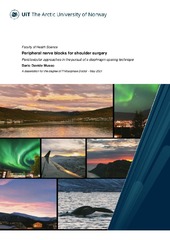Peripheral nerve blocks for shoulder surgery - Periclavicular approaches in the pursuit of a diaphragm-sparing technique
Permanent link
https://hdl.handle.net/10037/22019Date
2021-09-03Type
Doctoral thesisDoktorgradsavhandling
Author
Musso, Dario DavideAbstract
Background: Interscalene block is the gold standard for analgesia after shoulder surgery. However, it is associated with some block-related complications, especially the risk of hemidiaphragmatic paresis. In study I, we hypothesized that a more distal combination of nerve blocks would provide a feasible alternative to the gold standard. Study II was designed to optimize one of the components of the previous combination. In study III we wanted to put to the test the outcomes from the first two studies.
Methods: In study I, 20 patients undergoing arthroscopic shoulder surgery received a combination of superficial cervical plexus block (SCPB), suprascapular nerve block (SSNB), and lateral sagittal infraclavicular block (LSIB). In study II, 23 patients received an LSIB targeting the posterior and lateral cords, to estimate minimum effective volume in 50% and 95% of the patients (MEV50 - MEV95). In study III, 20 adult patients undergoing shoulder arthroplasty received a combination of SSNB and LSIB of the posterior and lateral cords.
Results: (I) 95% of patients underwent surgery with only light propofol sedation. (II) We estimated MEV50 = 7.8 ml and MEV95 = 9.0 ml. (III) surgery was performed under general anaesthesia with the above-mentioned nerve block combination. Median NRS (0-10) pain score 1, 3, 6, 8 and 24 hours postoperatively were 1, 0, 0, 0 and 3, respectively. During the first day, median NRS was 4, maximum NRS was 6.5. Total OMEq consumption was 52.5 mg. Incidence of hemidiaphragmatic paralysis was 5%.
Conclusions: (I) The combination of SCPB, SSNB and LSIB provides surgical anaesthesia and satisfactory postoperative analgesia after arthroscopic shoulder surgery. (II) MEV50 = 7.8 ml, MEV95 = 9.0 ml for LSIB targeting posterior and lateral cord: with ropivacaine 7.5 mg/ml. (III) The combination of SSNB and LSIB shows encouraging postoperative analgesia profile and low risk for hemidiaphragmatic paralysis.
Has part(s)
Paper I: Musso, D., Flohr-Madsen, S., Meknas, K., Wilsgaard, T., Ytrebø, L.M. & Klaastad, Ø. (2017). A novel combination of peripheral nerve blocks for arthroscopic shoulder surgery. Acta Anaesthesiologica Scandinavica, 61(9), 1192-1202. Also available at https://doi.org/10.1111/aas.12948. Accepted manuscript version available in Munin at https://hdl.handle.net/10037/15279.
Paper II: Musso, D., Klaastad, Ø., Wilsgaard, T. & Ytrebø, L.M. (2019). Brachial plexus block of the posterior and the lateral cord using ropivacaine 7.5 mg/mL. Acta Anaesthesiologica Scandinavica, 63(3), 389-395. Also available at https://doi.org/10.1111/aas.13277.
Paper III: Musso, D., Klaastad, Ø. & Ytrebø, L.M. (2021). A combination of infraclavicular and suprascapular never blocks for total shoulder arthroplasty: a case series. Acta Anaesthesiologica Scandinavica, 65(5), 674-680. Also available at https://doi.org/10.1111/aas.13787.
Publisher
UiT The Arctic University of NorwayUiT Norges arktiske universitet
Metadata
Show full item recordCollections
The following license file are associated with this item:


 English
English norsk
norsk
